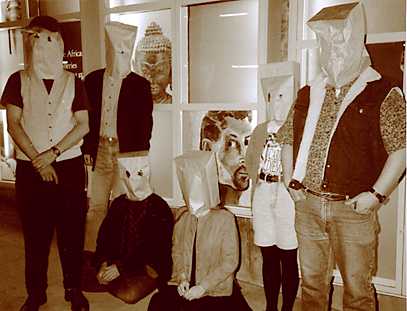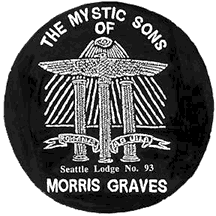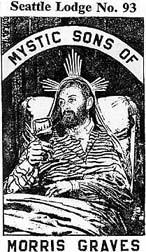Brotherhood of the Brush
 The causes of the perceived decline in the quality of life in modern America have
been analyzed at length. Among the more surprising findings in the studies of factors contributing to this disintegration of civility is the
dwindling membership in fraternal organizations, whose civic activism and familial structure were said to serve as an indispensable
foundation of our sense of community. The quaint pseudo-secrecy of these societies has been revived and updated by a group of artists in
the Northwest with the emergence of the Mystic Sons of Morris Graves, a fraternal brotherhood with an elusive aesthetic.
The causes of the perceived decline in the quality of life in modern America have
been analyzed at length. Among the more surprising findings in the studies of factors contributing to this disintegration of civility is the
dwindling membership in fraternal organizations, whose civic activism and familial structure were said to serve as an indispensable
foundation of our sense of community. The quaint pseudo-secrecy of these societies has been revived and updated by a group of artists in
the Northwest with the emergence of the Mystic Sons of Morris Graves, a fraternal brotherhood with an elusive aesthetic.
The inspiration for the Mystic Sons is Morris Graves himself, an octogenarian artist residing in blissful isolation on a picturesque estate in
northern California. A Seattle native and struggling regional artist, Graves rose to national attention as the focus of a feature article in
LIFE magazine in 1953 titled "Northwest Mystics." The story detailed an emerging art movement, with Graves at the center, informed by
Eastern philosophies and the natural beauty of the Pacific Rim in a charming and mysterious genre. The impact of this "Northwest Mystics
School" was felt for decades, enhanced by the elegance and eloquence of its primary practitioner. Graves became something of a fixture in
global high society. His work was featured in galleries and museums throughout the world, and his entourage included the biggest
celebrities of the day, from movie stars to royalty. In 1957 he became the only American artist to be honored with the prestigious Windsor
Award, presented personally by the Duke and Duchess themselves.
 An entire generation of Seattle artists came of age during Graves' reign as the only local painter to have ever achieved the status of a myth.
Even at the peak of his career, Graves maintained roots in the region, and inspired younger artists to remain productive. As the years
passed, however, and Seattle became a more cosmopolitan city, the influence of this visionary artist began to wane. A large creative
community migrated to the area, drawn by the low cost of living, natural surroundings, and a burgeoning youth culture. This influx of
talented young artists, together with Graves' increasingly reclusive lifestyle, ran the risk of causing collective aesthetic amnesia, with the
resulting loss of historical perspective in the visual arts. In an effort to keep the myth of Morris Graves alive, a not-so-secret fraternal order
was established in 1991.
An entire generation of Seattle artists came of age during Graves' reign as the only local painter to have ever achieved the status of a myth.
Even at the peak of his career, Graves maintained roots in the region, and inspired younger artists to remain productive. As the years
passed, however, and Seattle became a more cosmopolitan city, the influence of this visionary artist began to wane. A large creative
community migrated to the area, drawn by the low cost of living, natural surroundings, and a burgeoning youth culture. This influx of
talented young artists, together with Graves' increasingly reclusive lifestyle, ran the risk of causing collective aesthetic amnesia, with the
resulting loss of historical perspective in the visual arts. In an effort to keep the myth of Morris Graves alive, a not-so-secret fraternal order
was established in 1991.
The brainchild of artist Charles Krafft, Grand Polmarch of the Pacific Brotherhood, Seattle Lodge No. 93, this organization patterns itself
after early 20th century craftsman’s guilds. A lifetime admirer and close friend of Graves, Krafft says, "The primary goal of the Lodge is to
have fun." To that end, the Brothers have hosted several high profile receptions for visiting curators and artists of international repute. On
an educational level, the Mystic Sons have sponsored art exhibits like "Northwest Noir," a 1995 group show that generated considerable
regional media attention. "Northwest Noir was the flipside of the perceived wholesomeness of the Northwest lifestyle," says Krafft, the
exhibition organizer.
Lodge meetings of the Mystic Sons of Morris Graves are often rowdy affairs, with songs, cigars, numerology, and secret handshakes, all
presented with a flair of bacchanalian enthusiasm. These rituals are interspersed with stories of the fabled namesake’s exploits, which are
routinely enhanced for posterity. In lieu of membership dues, the Mystic Sons finance their activities with a prolific line of merchandise,
including Morris Graves trading cards, calendars, patches, ashtrays, and a two volume cassette recording of Lodge songs called Sing
Along with Morris Graves. For his part, Graves seems flattered by all the attention he’s getting from the younger set, frequently sending
priceless paintings for the archives and an occasional cash donation for important Lodge functions.
Initiation into the Mystic Sons is left to the whimsy of the Grand Polmarch. To qualify one must be male and exhibit an appreciation of the art
of the absurd. Halting efforts have been made to form a Women's Auxiliary, but members of the fairer sex seem reluctant to perform the
household chores that have been delegated to them. Interested men, however, may approach the Polmarch, who appears in full regalia at
many art functions in Seattle, and express their interest in joining the Society. You will score some points by reciting the sacred oath,
"Telergy, Torque, Obedience, and Krumhorns."


 The causes of the perceived decline in the quality of life in modern America have
been analyzed at length. Among the more surprising findings in the studies of factors contributing to this disintegration of civility is the
dwindling membership in fraternal organizations, whose civic activism and familial structure were said to serve as an indispensable
foundation of our sense of community. The quaint pseudo-secrecy of these societies has been revived and updated by a group of artists in
the Northwest with the emergence of the Mystic Sons of Morris Graves, a fraternal brotherhood with an elusive aesthetic.
The causes of the perceived decline in the quality of life in modern America have
been analyzed at length. Among the more surprising findings in the studies of factors contributing to this disintegration of civility is the
dwindling membership in fraternal organizations, whose civic activism and familial structure were said to serve as an indispensable
foundation of our sense of community. The quaint pseudo-secrecy of these societies has been revived and updated by a group of artists in
the Northwest with the emergence of the Mystic Sons of Morris Graves, a fraternal brotherhood with an elusive aesthetic. An entire generation of Seattle artists came of age during Graves' reign as the only local painter to have ever achieved the status of a myth.
Even at the peak of his career, Graves maintained roots in the region, and inspired younger artists to remain productive. As the years
passed, however, and Seattle became a more cosmopolitan city, the influence of this visionary artist began to wane. A large creative
community migrated to the area, drawn by the low cost of living, natural surroundings, and a burgeoning youth culture. This influx of
talented young artists, together with Graves' increasingly reclusive lifestyle, ran the risk of causing collective aesthetic amnesia, with the
resulting loss of historical perspective in the visual arts. In an effort to keep the myth of Morris Graves alive, a not-so-secret fraternal order
was established in 1991.
An entire generation of Seattle artists came of age during Graves' reign as the only local painter to have ever achieved the status of a myth.
Even at the peak of his career, Graves maintained roots in the region, and inspired younger artists to remain productive. As the years
passed, however, and Seattle became a more cosmopolitan city, the influence of this visionary artist began to wane. A large creative
community migrated to the area, drawn by the low cost of living, natural surroundings, and a burgeoning youth culture. This influx of
talented young artists, together with Graves' increasingly reclusive lifestyle, ran the risk of causing collective aesthetic amnesia, with the
resulting loss of historical perspective in the visual arts. In an effort to keep the myth of Morris Graves alive, a not-so-secret fraternal order
was established in 1991.